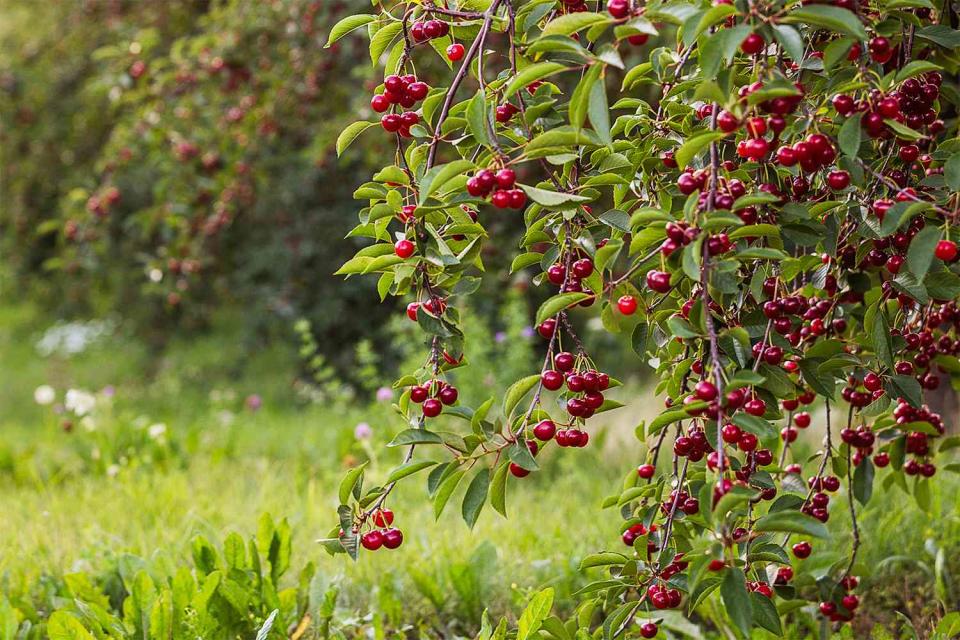How to Prune a Cherry Tree
Keep your cherry tree healthy and producing plenty of fruit with these trimming tips.

Bob Stefko
Cherry trees make beautiful additions to the garden with their profusion of spring flowers and vibrant yellow and orange fall foliage. Left to their own devices, standard cherries will grow into small trees with thick branching and a dense canopy of leaves, creating deep shade below. But to keep your trees producing full crops of cherries each year, annual pruning is in order. Whether you’ve planted just a couple of trees or a whole grove, here's what you need to know to easily and effectively prune your cherry trees for years of harvests ahead.
:
Types of Cherry Trees
When it comes to fruiting cherry trees, there are really two kinds: sour cherries (Prunus cerasus) and sweet cherries (Prunus avium).
1. Sour Cherries
Often called dwarf cherries for their smaller size, sour cherries will reach about 20 feet if allowed to grow unchecked on standard root stocks. These trees grow best in USDA Zones 4-6; they favor cooler climates and are also more disease and pest resistant than sweet cherries. Sour cherries are typically used in baking rather than eating fresh due to their tart flavor. Self-fertile cultivars like ‘Montmoren’ produce copious amounts of bright red fruit.
2. Sweet Cherries
Unlike sour cherries, sweet cherries can be harvested and eaten directly from the tree owing to their exceptionally sweet flavor. Standard sized (non-dwarf) sweet cherries will grow to about 35-40 feet with age and do best in Zones 5-8. At maturity, popular cultivars like ‘Bing’ can produce nearly 100 pounds of deep red fruit in a single year.
Why Prune Cherry Trees?
While you don't have to prune cherry trees, doing so has a number of benefits for your fruit harvest. As mentioned, cherry trees can reach great heights and an annual pruning benefits the grower by slowing the upward expansion of the tree, making them much easier to harvest. Another benefit is that regular pruning opens up the canopy of trees to allow greater air flow and light penetration. The more light, air flow, and access to pollinators, the more fruit can be produced.
:
When to Prune Cherry Trees
The best time to prune fruiting cherry trees is in late winter before leaves have begun to emerge for the season. While dormant, the full form and structure of the tree is visible and any broken or crossed branches can easily be identified. In some regions, sweet cherry trees can be more susceptible to bacterial and fungal diseases. Because of this, some growers might prefer to prune their sweet cherry trees in late summer after fruit has fully set.
Cherry Tree Pruning Tools and Materials
Before you begin pruning your trees, always be sure to sterilize your tools with a solution of one part bleach mixed into nine parts water. The bleach will kill any potential bacteria, fungi, or viruses waiting dormant on your tools to invade plants through wounds.
To prune cherries, you will need a pair of pruning shears, hand saw, and for taller trees, a pole saw. A pair of gloves, long sleeved shirt, pants, closed-toed shoes, and safety glasses are highly recommended when doing any pruning.
:
Tips for Pruning Cherry Trees
To begin pruning, first look for any broken or damaged limbs. Crossed branches will often rub together and produce seeping wounds, opening up the tree to infection. Dead branches will appear duller or lighter in color and should always be removed. Secondly, take a look at the base of the tree. Prune off any suckers or watersprouts coming from the base or along the stem. Branches below the graft union will not grow true to type and should never be allowed to grow.
Sour cherry trees should be grown in a large, vase-like shape. Newly planted and young trees should be “topped” by cutting the central leading stem. Rather, three to four lateral branches should be allowed to grow to provide the framework for the bulk of the tree. Ideally, these main lateral branches should be about 18-24 inches above the ground and evenly spaced to avoid future crowding.
:
Encourage further lateral branching by trimming off vertical, hanging, and thin branches. Prune off any branches growing toward the center of the canopy. Only remove about a third of previous year’s growth to encourage new growth. Sour cherries produce most of their fruit on the current year’s growth.
Unlike sour cherries, sweet cherries require less pruning than sour cherries and should be pruned along a central leader. As with sour cherries, remove any broken or crossed branches, vertical shoots that might compete with the central stem, and crowded growth. Encourage lateral branch development by pruning back by about a third. This will help in the development of new fruit buds.

